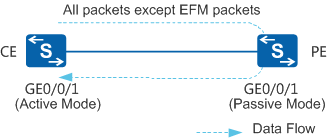Configuring Remote Loopback on the Device in Active Mode
Context
Remote loopback mainly tests connectivity and quality of a single link. In Figure 1, remote loopback is configured on the interface connecting the CE to the PE. The interface sends test packets to its remote interface. The packet loss ratio and delay can be calculated based on returned test packets to evaluate link connectivity and performance.

Remote loopback can only be initiated by an interface in active EFM mode.
Remote loopback affects data service forwarding. Therefore, it is recommended that you enable remote loopback to check link connectivity and quality before a new network is used or a link fault is rectified.
After the undo efm enable command is executed in the system view to disable EFM, all the EFM configuration is deleted. If remote loopback is performed on the device and many test packets are sent, running the undo efm enable command will cause test packets to be forwarded. As a result, network bandwidth is occupied.
- The S5720-EI, S6720-EI and S6720S-EI can only initiate EFM OAM remote loopback requests.
EFM can be configured on Layer 2 and Layer 3 Ethernet interfaces. By default, an Ethernet interface works in Layer 2 mode. Before configuring EFM on a Layer 3 Ethernet interface, switch the Ethernet interface to Layer 3 mode.
Pre-configuration Tasks
Perform the task of Configuring Basic EFM Functions.
Set the EFM mode to active for the interface that needs to be configured with remote loopback.
Procedure
- Enabling remote loopback on the device that initiates a request
Run system-view
The system view is displayed.
Run interface interface-type interface-number
The view of an interface in active EFM mode is displayed.
(Optional) On an Ethernet interface, run undo portswitch
The interface is switched to Layer 3 mode.
By default, an Ethernet interface works in Layer 2 mode.

Only the S5720-EI, S5720-HI, S5730-HI, S5731-H, S5731-S, S5731S-H, S5731S-S, S5732-H, S6720-EI, S6720-HI, S6720S-EI, S6730-H, S6730S-H, S6730-S, and S6730S-S support switching between Layer 2 and Layer 3 modes.
Run efm loopback start [ timeout timeout ]
The interface is configured to initiate remote loopback.
By default, the timeout interval for remote loopback is 20 minutes. After 20 minutes, remote loopback is disabled automatically. You are advised not to set the timeout interval to 0. If the timeout interval is set to 0, the link remains in remote loopback state.
Remote loopback is implemented successfully only when EFM protocols at the local end and the peer are in handshake state and EFM at the local end works in active mode. You can run the display efm session { all | interface interface-type interface-number } command to check whether the EFM status on both devices is detect. You can run the display efm { all | interface interface-type interface-number } command to check the EFM modes of the interfaces at both ends of a link.
- Configuring the interface in active EFM mode to send test packets

Only one interface can send EFM test packets at one time.
Run system-view
The system view is displayed.
Run test-packet start interface interface-type interface-number [ -c count | -s size ] *
The device is configured to send test packets.
By default, the size of a test packet is 64 bytes and the number of sent packets is 5. During test packet transmission, parameters of sent test packets cannot be changed.
The outbound interface of test packets should be the interface connected to the link to be tested.
Press Ctrl+C to stop sending test packets.
- Disabling remote loopback
Run system-view
The system view is displayed.
Run interface interface-type interface-number
The interface view is displayed.
(Optional) On an Ethernet interface, run undo portswitch
The interface is switched to Layer 3 mode.
By default, an Ethernet interface works in Layer 2 mode.

Only the S5720-EI, S5720-HI, S5730-HI, S5731-H, S5731-S, S5731S-H, S5731S-S, S5732-H, S6720-EI, S6720-HI, S6720S-EI, S6730-H, S6730S-H, S6730-S, and S6730S-S support switching between Layer 2 and Layer 3 modes.
Run efm loopback stop
Remote loopback is disabled on the interface.
By default, the timeout interval for remote loopback is 20 minutes.
If remote loopback is left enabled, the remote device continues to loop back service data, causing service interruption. To prevent this problem, you can configure a capability to automatically disable remote loopback after a specified timeout interval. After the timeout interval expires, the local device automatically sends a message to instruct the remote device to disable remote loopback. To manually disable remote loopback, you can perform the preceding procedures.
